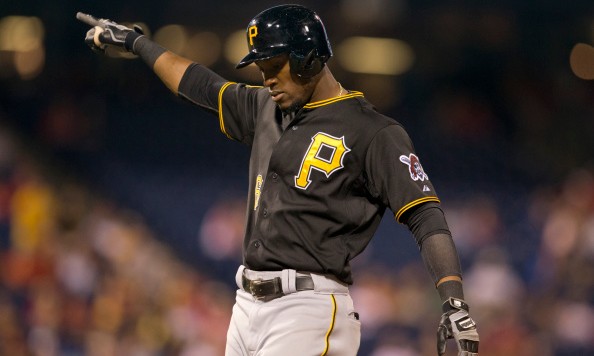This is an oft-repeated pre-season 2015 Pittsburgh Pirate trope:
If Starling Marte can play like he played in August and September last year, he’ll be a star.
This is a list of the outfielders in Major League Baseball to have more than 10 WAR (Baseball-Reference WAR, at least: UZR haaaaates the Pirates’ outfield defense and so both McCutchen and Marte score quite a bit lower at FanGraphs) combined in 2013 and 2014:
If you removed the names from this list, you wouldn’t guess that the fourth best outfielder in baseball over the last two years was waiting to “break out,” but for some reason, that’s the prevailing opinion with Marte.
Marte is kind of an interesting player; he doesn’t draw many walks and he’s got a crazy-high BABIP, so the saber crowd overlooks him a bit, while his strikeouts mean that I think maybe slightly more traditional fans get frustrated with him. As has been discussed quite a bit this winter, though, his walks are counterbalanced by that crazy HBP total, and his offensive style (speed and line drives) makes the BABIP potentially more sustainable than you might think.
What surpriseded me about this chart is how close Marte is to the player right above him. I’ve thought for a couple of years now that Carlos Gomez was probably Marte’s ceiling. Gomez has been a stealth MVP candidate for a couple of years in Milwaukee because he combines power and great defense with just enough AVG/OBP to be a well-rounded player. Marte’s power isn’t quite as good as Gomez’s (though I suspect Marte’s power numbers would be more impressive if he swapped PNC Park for Miller for 81 games a year), but otherwise he’s awfully close to him. If the way that Marte ended 2014 is really indication that he’s got another level to move to, he’s going to leave Gomez in the dust.
One other thing that I think is worth paying attention to with Marte is his career arc to this point. He first played in full-season ball in 2009, with West Virginia. He hit .312/.377/.439 that year to put himself on the prospect scene. He went to Bradenton the next year and hit .315/.386/.432, while dealing with a broken hamate. In 2011, he went to Altoona and blossomed, hitting .332/.370/.500 with 12 homers in 129 games. In 2012, his average fell a bit with Indianapolis but his walks went up and the power stayed: .286/.347/.500, a promotion to Pittsburgh, a home run on the first big league pitch he ever saw, and a .257/.300/.437 line in 47 games. In 2013, he hit .280/.343/.441. In 2014, he hit .291/.356/453. In his three big league seasons, his strikeout rate has gone from 27.5% to 24.4% to 24%. His walk rate has gone from 4.4% in his first two seasons to 6.1% last year.
In other words, it’s easy to trace an arc of improvement through Marte’s entire career, from his first year of US ball in 2009 through 2014. His power has been growing since returning from his hamate injury in 2010, and even though his plate discipline isn’t great, it’s certainly showing signs of improvement. Starling Marte is already an excellent big league outfielder. Depending on how you rate his defense, you can probably argue that he’s in the maybe the second tier of big league outfielders, behind the McCutchens and Trouts of the world, but in the mix with mostly everyone else. If we’re being completely honest and totally realistic, my guess is that the Marte we’ve seen the last two years is probably the Marte that we’re going to get for the next several, and there’s absolutely nothing wrong with that. Still, there’s that little voice in my head right now saying this: He won’t be 27 until October, and between that, the way he finished last year, the way his plate discipline is improving, and his general trend of year-to-year improvement up until now, it’s not unreasonable to hold out at least a little bit of hope that he hasn’t hit his ceiling yet. If that’s true and he can manage to get closer to that ceiling in 2015, I think the results could be pretty special.
Photo by Mitchell Leff/Getty Images




















